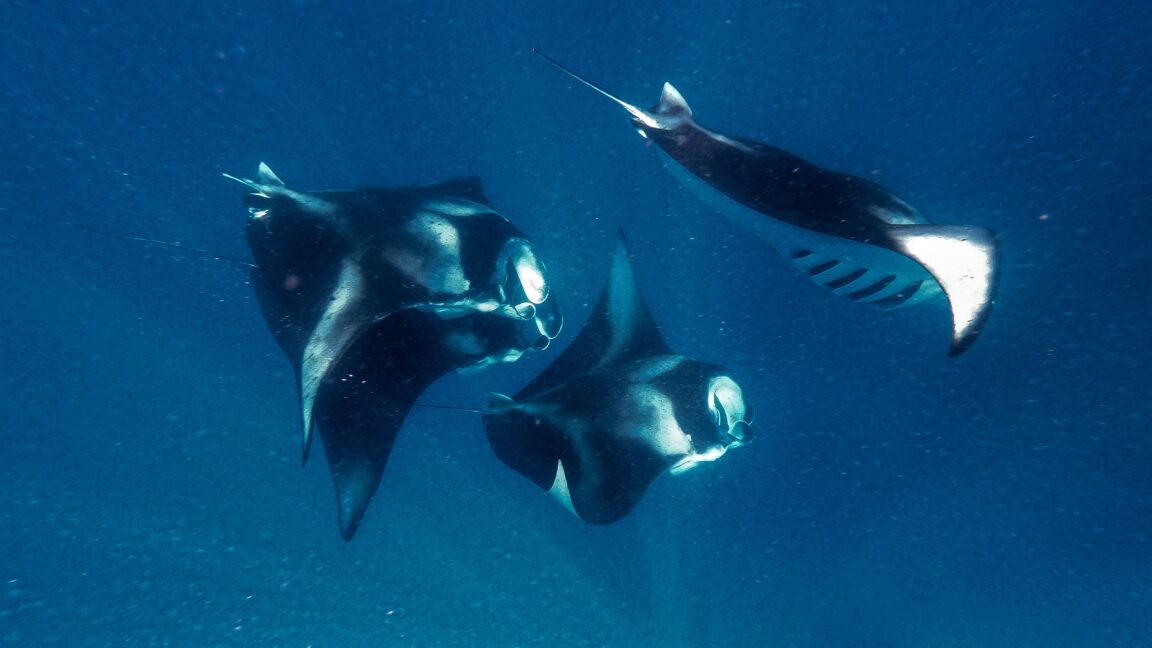
ARSTECHNICA.COM
Manta rays inspire faster swimming robots and better water filters
Bio-inspired Manta rays inspire faster swimming robots and better water filters Efficient swimming and feeding make the creatures a model for human machines. Elizabeth Rayne Dec 31, 2024 6:50 am | 1 manta rays feed in Hanifaru Marine Protected Area near the island of Dharavandhoo in Baa Atoll in the Maldives. Credit: MLADEN ANTONOV/AFP via Getty Images manta rays feed in Hanifaru Marine Protected Area near the island of Dharavandhoo in Baa Atoll in the Maldives. Credit: MLADEN ANTONOV/AFP via Getty Images Story textSizeSmallStandardLargeWidth *StandardWideLinksStandardOrange* Subscribers only Learn moreManta rays are elegantly shaped. They swim by flapping their fins like enormous wings, and their gills filter for plankton with the utmost precision. These creatures have now inspired human innovations that take soft robots and water filters to the next level.With fins that borrow their shape and motion from mantas, a soft robot created by a team of researchers at North Carolina State University and the University of Virginia improves on a previous model by reaching speeds of 6.8 body lengths per second, nearly double what its predecessor was capable of. This makes it the fastest soft robot so far. It is also more energy-efficient than its previous iteration and can swim not just on the surface, but upward and downward, just like an actual manta ray.Another research team at MIT used the gills of these creatures, which filter for plankton, to improve commercial water filtration systems. Their gill openings are also the perfect size to help them breathe while they feed, absorbing oxygen from water on its way out. The rays balance of feeding and breathing helped the researchers figure out a filter structure that more precisely controls inflow and outflow.Flying underwaterMantas get around with whats called mobuliform swimming. This involves oscillation, meaning that with each flap, the fins deform into a wave shape (kind of like a birds wings) before momentarily flattening out again and starting the process over.There is a particular speed-boosting aspect of manta ray swimming that the NC State and Virginia team wanted to take advantage of. The graceful oscillations of manta fins propagate waves that move outward from the rays body and create vortices that spiral, pushing water backward and producing forward thrust.The waveform shape of motions has a dramatic impact on the thrust generation, efficiency, and swimming speed, the team said in a study recently published in Science Advances.The new manta-robot has a body made of silicone and flexible wings that move exactly like those of a manta ray. When the body chamber is inflated, air actuates the robot: Its wings flap downward from their initially flat position. They momentarily return to their flat position as air is released from the chamber.This robot can also dive and come back to the surface. Faster flapping results in strong downward waves that will push the robot upward, while slower flapping creates weaker upward waves that allow it to go further down. (Actual mantas sink if they slow down.) It also proved it could fetch a payload from the bottom of a tank and bring it to the surface.Eating on the flyBecause manta rays are essentially giant moving water filters, researchers from MIT looked to them and other mobula rays (a group that includes mantas and devil rays) for inspiration when figuring out potential improvements to industrial water filters.Mantas feed by leaving their mouths open as they swim. At the bottom of either side of a mantas mouth are structures known as mouthplates, which look something like a dashboard air conditioner. When water enters the mouth, plankton particles too large to pass through the plates bounce further down into the mantas body cavity and, eventually, to its stomach. Gills absorb oxygen from the water that gushes out so the manta can breathe.The MIT team was especially interested in mobula rays because they thought the animals struck an ideal balance between allowing water in quickly enough to breathe while maintaining highly selective structures that prevent most plankton from escaping into the water. To create a filter as close to a mobula ray as possible, the team 3D-printed plates that were then glued together to create narrow openings between them. Particles that do not pass instead flow away into a waste reservoir.With slow pumping, water and smaller particles flowed out of the filter. When pumping was sped up, the water created a vortex in each opening that allowed water, but not particles, through. The team realized that this is how mobula rays are such successful filter feeders. They must know the right speed to swim so they can breathe and still get an optimal amount of plankton filtered into their mouths.The team thinks that incorporating vortex action will expand the traditional design of [industrial] filters, as they said in a study recently published in PNAS.Manta rays may look alien, but there is nothing sci-fi about how they use physics to their advantage, from powerful swimming to efficient (and simultaneous) eating and breathing. Sometimes nature comes through with the most ingenious tech upgrades.Science Advances, 2024. DOI: 10.1126/sciadv.adq4222PNAS, 2024. DOI: 10.1073/pnas.241001812Elizabeth Rayne Elizabeth Rayne is a creature who writes. Her work has appeared on SYFY WIRE, Space.com, Live Science, Grunge, Den of Geek, and Forbidden Futures. She lurks right outside New York City with her parrot, Lestat. When not writing, she is either shapeshifting, drawing, or cosplaying as a character nobody has ever heard of. Follow her on Threads and Instagram @quothravenrayne. 1 Comments
0 Σχόλια
0 Μοιράστηκε
98 Views


